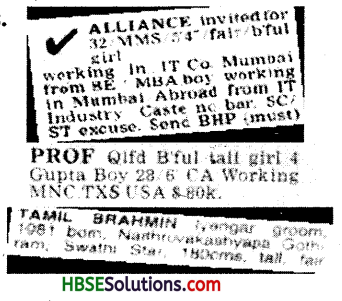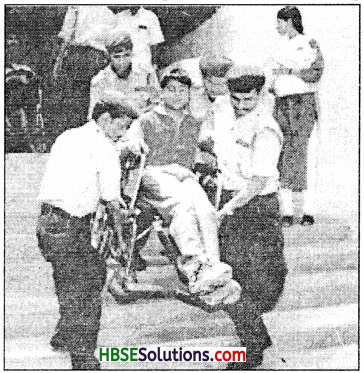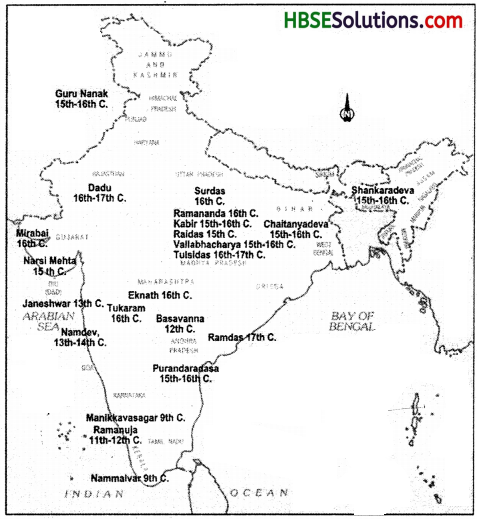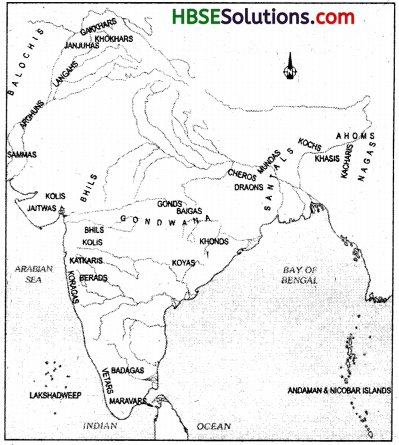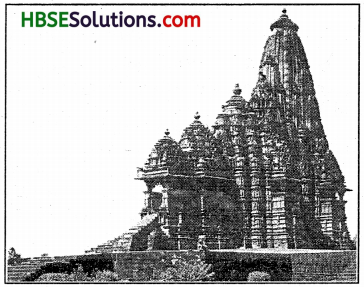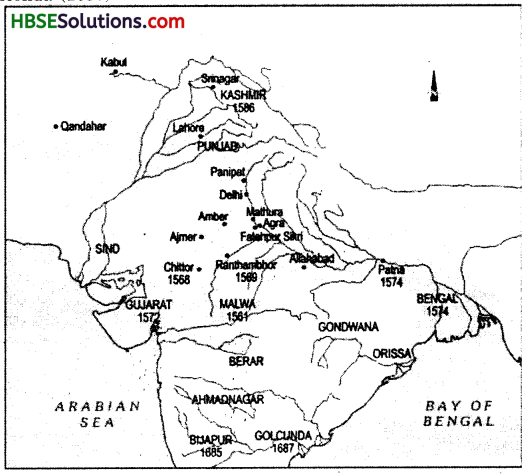HBSE 7th Class Social Science Solutions Civics Chapter 3 How the State Government Works
Haryana State Board HBSE 7th Class Social Science Solutions Civics Chapter 3 How the State Government Works Textbook Exercise Questions and Answers.
Haryana Board 7th Class Social Science Solutions Civics Chapter 3 How the State Government Works
HBSE 7th Class Civics How the State Government Works Textbook Questions and Answers
Question 1.
Use the terms ‘constituency’ and ‘represent’ to explain who an MLA is and how is the person elected?
Answer:
An MLA (Member of the Legislative Assembly) is a person affiliated with a political party.
A person is elected an MLA in the following manner:
(i) Every state is divided into different areas of constituencies.
(ii) The elections are held in each constituency.
(iii) All the adults above 18 years of age can vote.
(iv) The person who get the maximum votes is elected.
From each constituency people elect one representative who then becomes an MLA.
![]()
Question 2.
How did some MLA’s become ministers?
Answer:
(i ) After the elections, the party which obtains more than 50 percent of total seats is an Assembly is termed as the ruling party.
(ii) The members of the ruling party choose their leader who becomes the Chief Minister. The Governor gives oath to the Chief Minister.
(iii) The Chief Minister then nominates people as ministers from the ruling party or from outside.
(iv) The Governor of the states appoints them as ministers and gives oath to them.
Question 3.
Why should decisions taken by the Chief Minister and other ministers be debated in the Legislative Assembly?
Answer:
The decisions taken by the Chief Minister and other ministers should be debated in the Legislative Assembly because of the following reasons :
(i) MLA’s can express their opinion and ask questions related to the issues or give suggestions about what should be done by the government to implement policies for the peoples and . the state.
(ii) Adverse points in the decisions can be deleted.
Question 4.
What was the problem in Patal Puram? What discussion/action was taken by the following. Fill in the table.
| Public Meeting | |
| Legislative Assembly | |
| Press Conference | |
| Chief Minister |
Answer:
Patalpuram was facing the problem of shortage of water and sanitation which had caused diarrhoea in the city.
(i) Public Meeting: Meeting, people raised voice to bring sanitation in the area and control diarrhoea.
(ii) Legislative Assembly : The discussion based on bad conditions in hospital, shortage of water, proper doctors in Patalpuram.
(iii) Press Conference : The health ; minister explained the steps taken by the government to check diarrohea and supply safe drinking water.
(iv) Chief Minister : Chief Minister explained the residents of Patalpuram that the due compensation would be given to the kins of the dead.
Question 5.
What is the difference between the work that MLAs do in the Assembly and the work done by the government department?
Answer:
An MLA works for the welfare of his people and is even responsible for wrong doings. > MLA’s raise the issue in the Assembly and want solution to the problems facing the masses. Government departments make laws. The various government departments also implement these laws.
EXRCISE
Question 1.
(i) What is happening in Patalpuram?
(ii) Why is this problem serious?
(iii) What action do you think can be taken in above situations and who do you think should take the action? ‘ .
Answer:
(i) The district headquarter of Patalpuram was facing the problem of shortage of water and sanitation.
(ii) This problem was serious because a large number of people were facing the problem of acute diarrhoea.
(iii) The municipal committee should take immediate actions with the help of state governments to control the situation.
Question 2.
Write two measures that the government undertook for controlling diarrhoea.
Answer:
The government undertook the following measures for controlling garbage :
(a) Removal of garbage,
(b) Arrangement of drinking water through tanker trucks.
Question 3.
What is the purpose of a press conference? How does the press conference help you get information on what the government is doing?
Ans.
The purpose of press conference is to hear about or ask questions on a particular issue about the steps. The data collected by press conference is printed in newspapers for the common people.
Question 4.
M. times, the ruling party may not be a single party but a group of parties working together. This is called a coalition. Discuss with your teacher.
Answer:
The coalition is formed by two of more parties coming together. The parties come together and elect their leader. The governor appoints their leader as CM. The coalition party prepares a Common Minimum Programme and f execute the programme during the period for which coalition is formed.
Question 5.
What were the main arguments put forward by different MLAs who thought that the government was not taking the situation in a serious manner and what were the opposition party.
Answer:
Debate : Opposition Party MLA, 1 put forward the problem of diarrhoea in his constituency of Akhandagaon. He wanted to draw the attention of minister to solve the problem.
MLA 2 (Opposition Party): Commented upon the bad situation of hospitals. He wanted to know about the government plans to control the epidemics.
MLA 3 (Opposition Party): Belonged to the constituency of Tolpatti which faced a serious shortage of water. He wanted to confirm if the government is taking actions to clean and disinfect the wells and ponds.
MLA 4 (Ruling Party) : However, supported the government telling that water tankers have been put into service and ORS packets were distributed.
MLA 5 (Opposition Party): Commented upon the bad deteriorating situation in hospitals.
MLA 6 (Ruling Party): Told about the negligence of the previous party and actions being taken by the ruling party to clear the garbage.
![]()
Question 6.
If you were the health minister, how would you respond to the above discussion?
Answer:
- I would have taken the immediate action to solve, the problem in each area.
- I would have started special doctors and started the mobile health care vans with all the necessary equipment.
Question 7.
Do you think the above debate would have been useful in some ways? How? Discuss.
Answer:
Yes, because it has brought forward many issues concerning public wealth made the health minister aware about the serious situation and immediate need of the hour.
Question 8.
In the working of the government, explains the difference being on MLA and an MLA who is also a minister.
Answer:
An MLA highlights some issues in the assembly and can suggest some solutions. An MLA who is a minister takes the decision and implements it.
HBSE 7th Class Civics How the State Government Works Important Questions and Answers
Very Short Answer Type Questions
Question 1.
What do you mean by MLA?
Answer:
The members of legislative assembly is called MLA.
Question 2.
Who becomes the Chief Minister of a State?
Answer:
The leader of the majority party becomes the Chief Minister of a State.
Question 3.
What does the word ‘government’ refer to?
Answer:
The word ‘government’ refers to the government departments and the various ministers who head them.
Short Answer Type Questions
Question 1.
What is a Legislative Assembly?
Answer:
A Legislative Assembly is a place where all the MLAs, whether from the ruling party or from the opposition meet to discuss issues/problems of urgent needs, a bill introduced for making law, etc. .
Question 2.
Who takes decisions and run the government in a State?
Answer:
(a) The Chief Minister and other Ministers take decisions on behalf of the government in the State.
(b) The Chief Minister alongwith his Council of Ministers implements the programmes of the Government and thus run the Government.
Question 3.
What is legislative and what does it do?
Answer:
(a) All the MLAs in the legislative assembly together constitute the legislature.
(b) They take part in debate, approve the policy and programmes of the government and supervise the actions taken of the gdMemment outside the assembly.
![]()
Question 4.
What is relation between law, the Legislative Assembly and the government?
Answer:
(i) Any bill introduced in the Legislative Assembly when is passed by majority of the MLAs is called law.
(ii) A law made by the State Legislative Assembly is enforced in the State by the Government of the State.
Long Answer Type Questions
Question 1.
Write a brief note on a debate held in the Legislative Assembly of a State?
Answer:
(a) A debate can be held in a Legislative Assembly on a specific problem of urgent food.
(b) During the debate, MLAs express their opinion and ask questions related to the issue.
(c) They also give suggestions about what should be done by the government.
(d) The concerned minister replies to the questions. He/She also tries to assure the Assembly that adequate steps are being taken.
Question 2.
Write about the democratic process adopted for the formation of Government in a State.
Answer:
(a) It is the democracy through which the people of 18 years and above elect their representatives as the members of legislative assembly (MLAs).
(b) The MLAs of the majority party elect their leader who is appointed the Chief Minister of the State by the Governor.
(c) The Ghief Minister selects some MLAs to head different departments/ministeries and they are appointed as ministers by the Governor of the State.
Thus, a Government is formed in a State by democratic process.
How the State Government Works Class 7 HBSE Notes
- Constituency: A particular area from which all the voters living there choose their representatives. For example, a panchayat ward or an area that chooses an MLA.
- Majority: Majority is a situation when more than half the number in a group supports a decision or an idea. This is also called a simple majority.
- Opposition: This refers to elect representatives who are not members of the ruling party and who play the role on questioning government decisions and actions as well as raising new issues for consideration in the Assembly.
- Press Conference: A gathering of journalists from the media who are invited to hear about and ask questions on a particular issue and are then expected to report On this to the larger public.
- Epidemic: A disease that attacks a large number of people in an area at the same time is called an epidemic.
- Ruling Party: The political party which has more than 50 percent of the total representatives in Panchayat, Corporation, Assembly, or Parliament is known as the Ruling Party.
